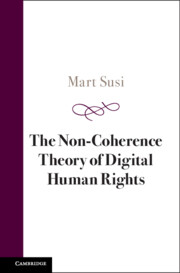2 results
14 - The Variance Principle and Digital Transparency
- from Part III - The Core Elements of Non-coherence Theory
-
- Book:
- The Non-Coherence Theory of Digital Human Rights
- Published online:
- 22 February 2024
- Print publication:
- 29 February 2024, pp 165-178
-
- Chapter
- Export citation

The Non-Coherence Theory of Digital Human Rights
-
- Published online:
- 22 February 2024
- Print publication:
- 29 February 2024

